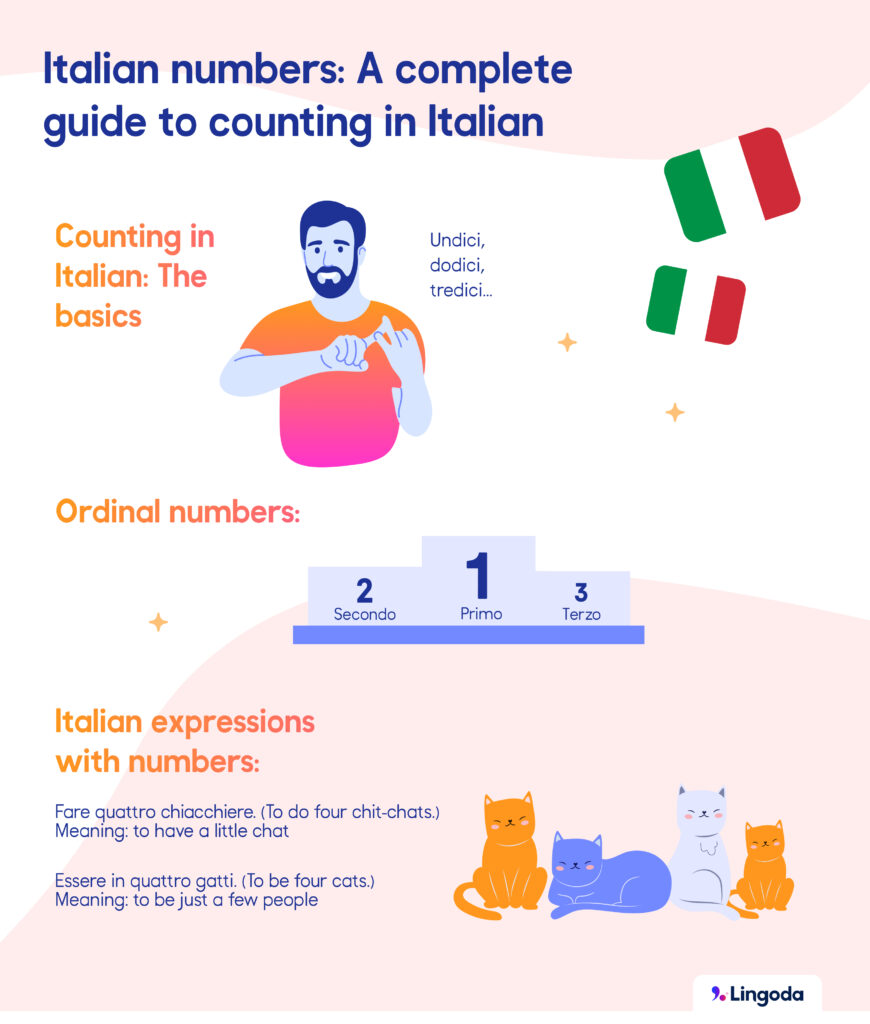Updated on January 14, 2025

Italian numbers: A complete guide to counting in Italian

Did you miss your class on Italian numbers? Time to catch up! Whether you’re ordering coffee, catching a train, or negotiating prices at a local market, knowing how to count and use numbers in Italian is essential.
In this article, we’ll dive into Italian numbers, from basic digits to the dates, prices and idiomatic expressions in which numbers appear on a daily basis. We’ll also point out some patterns, pronunciation tips and practical examples that will help you develop a more intuitive understanding of Italian numbers.



Italian and Spanish numbers share Latin roots, so if you’ve already learned the basic numbers (1–10) in Spanish, you’ll be glad to know they’re nearly identical in Italian. Some English numbers also derive from Latin, so you shouldn’t have trouble remembering the Italian numbers tre (three), sei (six) and nove (nine), among others.
| English | Italian | Pronunciation |
| one | uno | oo-noh |
| two | due | doo-eh |
| three | tre | treh |
| four | quattro | kwah-troh |
| five | cinque | cheen-kweh |
| six | sei | say-ee |
| seven | sette | set-teh |
| eight | otto | oht-toh |
| nine | nove | noh-veh |
| ten | dieci | dyay-chee |
Numbers 11–16 combine a unique prefix with the suffix –dici, derived from dieci (ten). For numbers 17–19, the order flips; these numbers combine the prefix dici– with a unique suffix.
| English | Italian | Pronunciation |
| eleven | undici | oon-dee-chee |
| twelve | dodici | doh-dee-chee |
| thirteen | tredici | treh-dee-chee |
| fourteen | quattordici | kwa-tor-dee-chee |
| fifteen | quindici | kween-dee-chee |
| sixteen | sedici | seh-dee-chee |
| seventeen | diciassette | dee-chah-set-teh |
| eighteen | diciotto | dee-chot-toh |
| nineteen | dicianove | dee-chah-noh-veh |
| twenty | venti | ven-tee |
Numbers 21–99 are formed by combining the appropriate tenth decimal prefix (venti, trenta, etc.) with the appropriate unit (uno, due, etc.). Notice that the final vowel of the prefix is dropped before uno and otto for smoother pronunciation, so instead of saying ventiuno or ventiotto, we would say ventuno and ventotto.
| English | Italian | Pronunciation |
| twenty-one | ventuno | ven-too-noh |
| thirty | trenta | tren-tah |
| thirty-two | trentadue | tren-tah-doo-eh |
| forty | quaranta | kwa-rahn-tah |
| forty-three | quarantatré | kwa-rahn-tah-treh |
| fifty | cinquanta | cheen-kwan-tah |
| fifty-four | cinquantaquattro | cheen-kwan-tah-kwah-troh |
| sixty | sessanta | ses-sahn-tah |
| sixty-five | sessantacinque | ses-sahn-tah-cheen-kweh |
| seventy | settanta | set-tahn-tah |
| seventy-six | settantasei | set-tahn-tah-say-ee |
| eighty | ottanta | oht-tahn-tah |
| eighty-seven | ottantasette | oht-tahn-tah-set-teh |
| ninety | novanta | noh-vahn-tah |
| ninety-eight | novantotto | noh-vahn-toht-toh |
| one hundred | cento | chen-toh |
| English | Italian | Pronunciation |
| one hundred eighty-three | centottantatré | chen-toh-tan-tah-treh |
| two hundred | duecento | dweh-chen-toh |
| two hundred fifty-eight | duecentocinquantotto | dweh-chen-toh-cheen-kwan-toht-toh |
| three hundred | trecento | treh-chen-toh |
| three hundred twenty-six | trecentoventisei | treh-chen-toh-ven-tee-say |
| four hundred | quattrocento | kwah-troh-chen-toh |
| four hundred twelve | quattrocentododici | kwah-troh-chen-toh-doh-dee-chee |
| five hundred | cinquecento | cheen-kwe-chen-toh |
| five hundred two | cinquecentodue | cheen-kwe-chen-toh-doo-eh |
| six hundred | seicento | say-chen-toh |
| six hundred ninety-one | seicentonovantuno | say-chen-toh-noh-van-too-noh |
| seven hundred | settecento | set-teh-chen-toh |
| seven hundred twenty-eight | settecentoventotto | set-teh-chen-toh-noh-ven-toht-toh |
| eight hundred | ottocento | oht-toh-chen-toh |
| eight hundred ten | ottocentodieci | oht-toh-chen-toh-dee-eh-chee |
| nine hundred | novecento | noh-veh-chen-toh |
| nine hundred forty | novecentoquaranta | noh-veh-chen-toh-kwah-rahn-tah |
| one thousand | mille | mee-leh |
| two thousand | duemila | doo-eh-mee-lah |
| ten thousand | diecimila | dyeh-chee-mee-lah |
| one hundred thousand | centomila | chen-to-mee-lah |
| one million | un milione | oon mee-lyoh-neh |
| two million | due milioni | doo-eh mee-lyoh-nee |
| one billion | un miliardo | oon mee-lyar-doh |

Ordinal numbers indicate positions in a sequence (first, second, third, etc.). You can use them to clarify rankings, dates, floors in buildings, and chapters or lessons. Keep in mind that ordinal numbers must agree in gender and number with the noun they modify.
| English | Italian | Pronunciation |
| first | primo/a | pree-moh/mah |
| second | secondo/a | seh-kon-doh/dah |
| third | terzo/a | ter-tsoh/tsah |
| fourth | quarto/a | kwar-toh/tah |
| fifth | quinto/a | keen-toh/tah |
| sixth | sesto/a | ses-toh/tah |
| seventh | settimo/a | set-tee-moh/mah |
| eighth | ottavo/a | ot-tah-voh/vah |
| ninth | nono/a | noh-noh/nah |
| tenth | decimo/a | deh-chee-moh/mah |
| English | Italian |
| one o’clock | l’una |
| two o’clock | le due |
| noon | mezzogiorno |
| midnight | mezzanotte |
| quarter past three | le tre e un quarto |
| half past four | le quattro e mezza |
| today | oggi |
| tomorrow | domani |
| yesterday | ieri |
| first week of the month | la prima settimana del mese |
| May the 1st | il primo di maggio |
| English | Italian |
| price | il prezzo |
| one euro | un euro |
| ten euros | dieci euro |
| 50 cents | cinquanta centesimi |
| 300 grams | tre etti (un etto = 100g) |
| 150 grams | un etto e mezzo |
| discount | lo sconto |
| sale | i saldi |
| receipt | lo scontrino |
| a kilo | un chilo |
| a dozen | una dozzina |
| English | Italian |
| phone number | il numero di telefono |
| area code | il prefisso |
| address | l’indirizzo |
| floor | il piano |
| house number | il numero civico |
| zip code | il codice postale |
Numbers frequently appear in Italian idiomatic expressions, proverbs and sayings, often carrying symbolic or cultural significance.
Uno, due, tre, quattro, cinque, sei, sette, otto, nove, dieci, undici, dodici, tredici, quattordici, quindici, sedici, diciassette, diciotto, diciannove, venti.
For 21, 31 and further numbers, combine the tenth decimal prefix with the unit (venti + uno = ventuno). Drop the final vowel of the prefix (venti, trenta) before uno and otto (ventotto).
Our top three tips are: practice counting aloud, notice the patterns (dici for 11–19 or -anta for 30+) and use real-life examples like prices or dates to reinforce learning.
From telling time to shopping, from sharing addresses to making plans, numbers in Italian are present constantly.
Want to learn Italian in a supportive environment? Lingoda’s small group classes, flexible scheduling and native-level teachers provide the perfect space to refine your Italian skills. Whether you’re counting to ten or learning idiomatic phrases, you can count on us for an effective learning journey!


